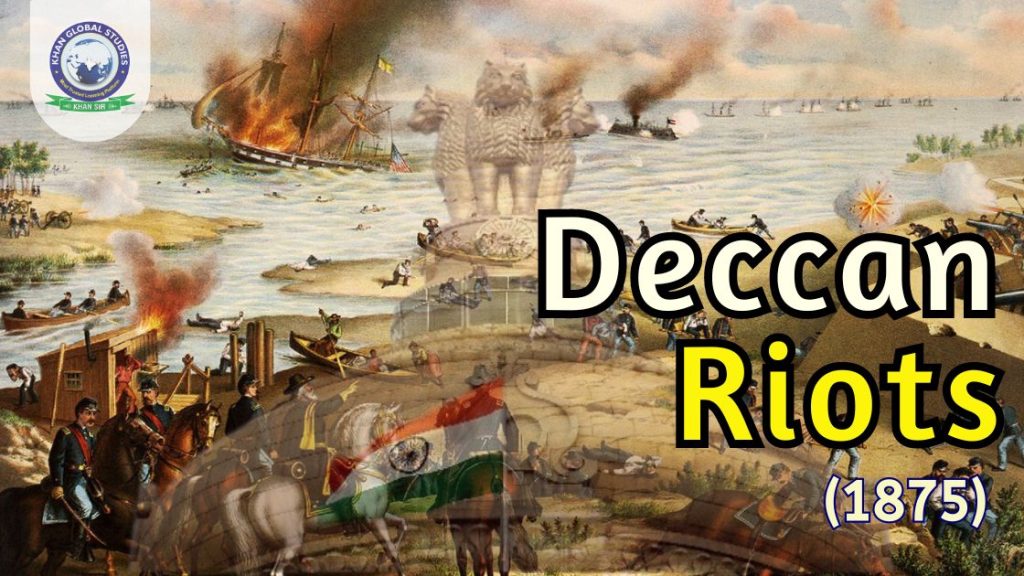The late 19th century saw significant agrarian distress in Maharashtra, leading to a notable peasant rebellion in 1875 known as the Deccan Rebellion. In this rebellion, the farmers of Maharashtra started a revolution against the increasing agricultural crisis.
| Name of Rebellion | Deccan Rebellion |
| Beginning of Rebellion | 1875 (Maharashtra) |
| Cause of Rebellion | Peasants in Maharashtra, mainly in the districts of Poona, Satara and Ahmednagar, revolted in 1875 in response to the dishonest business practices of Gujarati and Marwari moneylenders and the growing agrarian crisis. |
| Purpose of Rebellion | Destroying the books of moneylenders and obtaining documents. |
| Result of Rebellion | The government established the Deccan Riots Inquiry Committee in 1877. To suppress the movement and protect the farmers from moneylenders, the Deccan Peasants’ Relief Act-1879 was enacted by the government in 1897. |
About Deccan Riots
In 1867 the government increased the land income by 50% and in 1875 the Deccan Rebellion broke out and the condition of the farmers worsened. Peasants in Maharashtra began Riots in 1875 in response to the growing agrarian crisis. They started this rebellion in protest against the high-interest rates charged by moneylenders on their property and crops.
What was the Deccan Rebellion in 1875?
The Deccan Riots of 1875 is being explained in the following points:
- The Deccan Riots started from Supa village in Poona district. The farmers were led by village heads.
- In 1875 farmers attacked a market where many moneylenders lived. They had burnt the books and accounts.
- The main objective of the farmers was to destroy the account books of the moneylenders.
- Farmers also socially boycotted the moneylenders.
- This rebellion continued for 2 months and spread to more than 30 villages.
- It took several months for the police to restore order in the rural areas.
- The Bombay government initially dismissed the rebellion as minor.
- The Government of India had asked Bombay to investigate this matter.
- Because of the rebellion, the Deccan Riot Commission was set up which presented a report in the British Parliament in 1878.
- The Farmers’ Relief Act was passed in 1879 and ensured that farmers would not be arrested or sent to jail if they could not repay their debts.
What is the history of the Deccan Riots?
The British established the Ryotwari settlement as a land revenue system in the Bombay Deccan region. Under this, revenue from land was determined every year. In the Ryotwari system, there was an agreement between the government and the ryots. Therefore due to high revenues farmers found it challenging to pay their taxes and hence farmers borrowed money from moneylenders to pay their expenses. After producers took out loans, they discovered that the interest rates were unreasonably high, making repayment impossible.
Debt became a major problem among farmers in rural areas. Civil conflict broke out in the United States in 1861. The largest source of cotton for the British was the United States. When the Civil War started, the demand for cotton from India increased, due to which cotton cultivation increased there, but after the American conflict ended, the demand for cotton decreased and farmers had to suffer losses.
Farmers were no longer eligible to borrow from the moneylenders who had previously been generous with their loans during the Civil War. The farmers were angry because they were completely dependent on the moneylenders and they did not care about their condition.
What was the cause of the Deccan Riots?
If we look at the causes of the Deccan riots, farmers in Maharashtra, mainly in the districts of Poona, Satara and Ahmednagar, Riotsed in 1875 against the dishonest business practices of Gujarati and Marwari moneylenders.
Moneylenders manipulated the accounts of poor farmers and charged exorbitant interest rates on loans. As a result, the ryots launched a social boycott campaign against the moneylenders and refused to labour in their homes and fields or buy goods from their shops.
This social exclusion led to agrarian unrest and attacks on the homes and businesses of moneylenders by ryots. Loan bonds, decrees and other documents of moneylenders were confiscated.
What was the objective of the Deccan Riots?
The purpose of the Deccan riots was to destroy the books of accounts of moneylenders and obtain documents. Under the Ryotwari system, farmers suffered losses due to heavy tax demands and stringent revenue collection schedules and farmers remained adamant in their demands against it.
What was the result of the Deccan Riots?
The government established the Deccan Riots Inquiry Committee in 1877. According to the Commission, the primary causes of the rebellion were poverty and debt. In an attempt to suppress the movement and protect the farmers from moneylenders, the Deccan Peasants’ Relief Act-1879 was implemented by the government in 1897.
The Deccan riots of 1875 reflect the socio-economic changes that took place in rural Maharashtra during the first 50 years of British control in Western India. Social historians are particularly interested in the riots because they have focused on the interaction between two different rural social groups, farmers and moneylenders.
About the Deccan Riot Commission
The Bombay administration suspected that the rebellion had spread to the entire Deccan region. However, the Bombay Government constituted a committee to investigate the causes of the riots and the report prepared by the commission was welcomed. In 1878 it was handed over to the British Parliament. This document is known as the Deccan Riots Report.
When the irregularities were investigated, the Commission investigated the matter based on information received from the ryots, moneylenders and eyewitnesses of the districts where the irregularities were highest. The commission also compiled reports from the district and data on revenue rates, pricing and interest rates in different areas.
FAQs
Question: Where did the Deccan Riots start?
Answer: Deccan rebellion took place in Maharashtra.
Question: What was the cause of the Deccan Riots of 1875?
Answer: The Deccan riots were caused by high land revenues, heavy interest rates on loans, and severe farmer indebtedness due to the sudden decline in demand for cotton after the end of the American Civil War.
Question: Who started the Deccan Rebellion of 1875?
Answer: The Deccan Riots were started by the farmers of Maharashtra.



